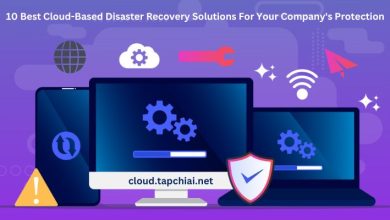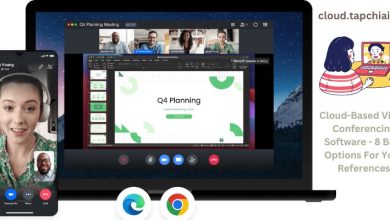Cloud-Based Enterprise Resource Planning Software – Best Definition And 5 Difference Types

Cloud-based enterprise resource planning software – Are you considering starting a new business unit? If so, you must oversee everything pertaining to the product or service. Even you must plan sound management while being supervised by a team of knowledgeable and experienced individuals. In addition, you need to maintain a strong ERP system. In this article, with cloud.tapchiai.net, let’s find out some useful information about cloud-based enterprise resource planning software!
Contents
1. Cloud-based enterprise resource planning software – What is it?

Now we see it appearing more with the abbreviation of cloud-based ERP software. Enterprise resource planning (ERP) software and tools are part of a system called cloud-based ERP that is hosted and managed by your vendor remotely on the cloud. You can concentrate on managing your business instead of managing IT with cloud deployment.
In SaaS solutions that are cloud-based, the vendor is responsible for management and maintenance, not your company. The continuous and smooth software upgrades provided by cloud ERP are already covered by your one one-time, recurring subscription.
Additionally, since the implementation of cloud ERP requires little to no IT involvement, your team will be able to contribute more to the business by spending more time on projects that support long-term growth strategies.
Your ERP system can assist you in refocusing on business objectives rather than technology in the cloud. You can stay up with the quick speed of technological progress with the assistance of the automated updates. One of the most unanticipated outcomes of switching from an on-premises ERP solution to cloud ERP, according to company executives, is their ability to keep and become current. If you have quick access to more cutting-edge business software, you may create a competitive advantage that expands and changes with the market.
2. Components of cloud-based enterprise resource planning software
All cloud-based enterprise resource planning software include the fundamental accounting and financial functions. From then, an organization’s choice of modules or applications is determined by its industry and particular business requirements. There are the following cloud-based ERP modules:
- Accountancy and finance.
- Either human resource management software (HRMS) or human capital management (HCM).
- CRM stands for customer relationship management.
- Inventory control.
- Orderly execution.
- Procurement.
- Supply chain administration.
- Project administration.
- Planning for material needs (MRP).
3. Cloud-based enterprise resource planning software – Concepts

As we go deeper into the topic, it’s crucial to comprehend several fundamental ideas related to cloud ERP:
- Cloud-based enterprise resource planning software can be purchased in a “as a service” manner or installed on-site or on privately hosted servers. Although cloud ERP functionality is typically more swiftly supplied, businesses must still budget time for planning, data transfer, customization and configuration, and employee training.
- ERP that is hosted remotely on the servers of the ERP provider and made available as a service via a web browser is known as cloud-based ERP.
- On-premises ERP: Locally installed enterprise resource planning software that is controlled by in-house or external IT employees and is kept up to date on a company’s PCs and servers. The program and the infrastructure that supports it are internally controlled, stored, and maintained.
- Hosted ERP: The implementation of cloud-based enterprise resource planning software and related infrastructure is managed by a business or hosting provider. When companies want to outsource their IT operations, hosted deployment options are frequently used. Even while this configuration has certain cloud-related advantages, it is not a genuine “as a service” architecture.
- End-to-end security: A protected and encrypted link between a cloud-based ERP provider and its clients.
- Licensing via subscription: To use the program, the business must pay a set subscription cost on a regular basis (either monthly or yearly). It can be charged either per person or per company, and it typically covers all software maintenance and updates.
4. Cloud-based enterprise resource planning software – Different types

First of all, not every cloud is made equally. In order to run from their own internet-connected data centers, some traditional ERP suppliers have upgraded their software. The full advantages of cloud-based enterprise resource planning software, such as streamlined updates and the power of the cloud data center paradigm, where a sizable pool of resources supports applications rather than allocating infrastructure to specific software components, may not be realized by businesses who deploy these ERP systems.
Additional variations of cloud cloud-based enterprise resource planning software include:
- Multi-tenant SaaS: A single instance of the ERP software and the infrastructure that supports it serves numerous businesses. The data of one organization is not accessible to those of another despite the fact that they all use the same software and are located on the same servers. A multi-tenant SaaS is often a genuine cloud ERP solution.
- Single-tenant SaaS: One organization is served by a single instance of the ERP software and the infrastructure that supports it. In other words, private servers running a particular software instance host the data of a business. Customers may choose between running a private instance and a shared instance from some cloud ERP companies.
- Public cloud: Multiple businesses share cloud computing services on this service provider-owned cloud. Data and applications are exclusive to each business, though. Oracle Cloud, Google Cloud, Microsoft Azure, and Amazon Web Services are a few examples of public clouds.
- A service that is exclusive to one organization is known as a private cloud.
- Hybrid ERP: An method to ERP that, as the name suggests, mixes on-premises software with private or public clouds for computation, storage, and services.
Conclusion
Businesses who adopt systems like cloud-based ERP may anticipate a 30 to 40% boost in productivity over the next several years because to the increased process efficiency these solutions provide. Small startups will benefit from increased process speed and mobility thanks to less overhead, increased efficiency, and smaller, less heavy onsite equipment. As a result, these companies will be able to expand more quickly and join the big leagues.
I hope you found this article about cloud-based enterprise resource planning software useful. Have a good day!
Conclusion: So above is the Cloud-Based Enterprise Resource Planning Software – Best Definition And 5 Difference Types article. Hopefully with this article you can help you in life, always follow and read our good articles on the website: Cloud.tapchiai.net




